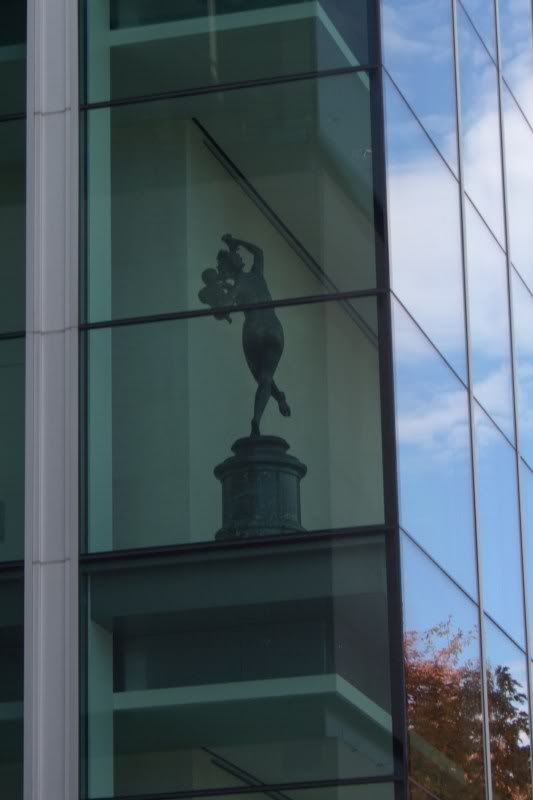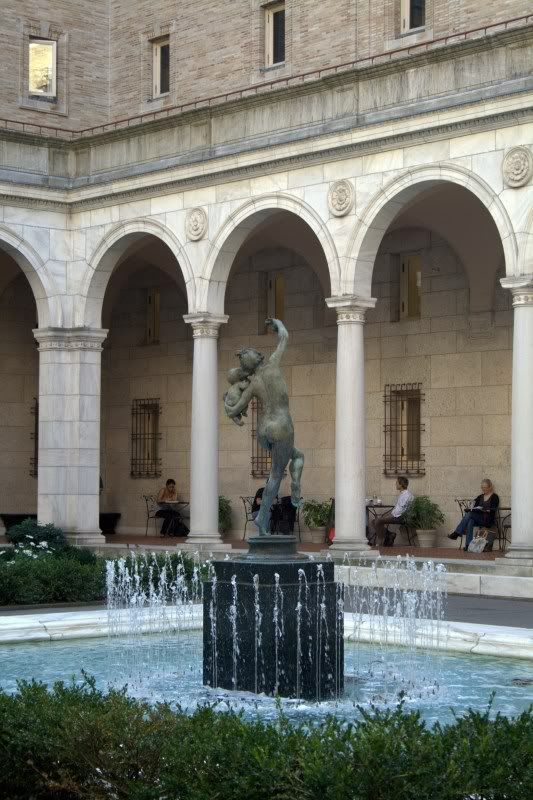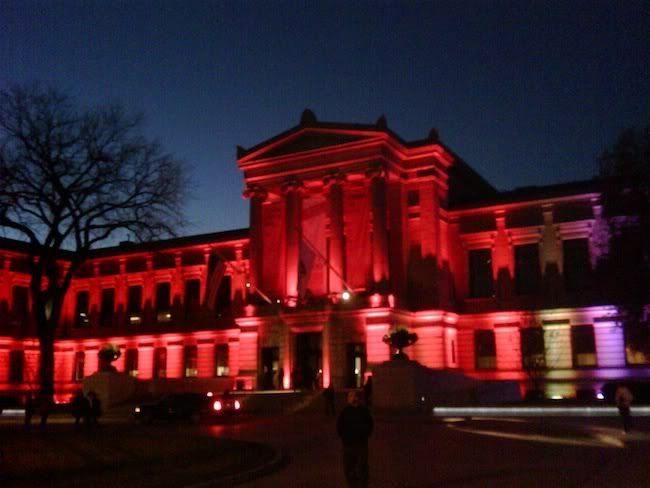The picture of calm
Designing the inside of the MFA's soon-to-be-unveiled $504 million wing ? and juggling all the endless details that requires ? could unnerve lesser talents. Not Keith Crippen.
By James Sullivan | October 17, 2010
As the busy head designer of the Museum of Fine Arts? ambitious, eagerly anticipated new Art of the Americas wing, Keith Crippen can be forgiven for neglecting the visual appeal of his own office space. Above the clutter of strewn notebooks and wallpaper samples, a poster-size photo print of his two boys hangs from the wall, curling at the edges. One of his sons brandishes a butterfly net like a weapon; the other has a beach bucket on his head.
?Hooligans,? says the easygoing Crippen with a smile. Clearly, the man has some expertise in dealing with disorder.
With just weeks to go before the MFA throws open the doors to its $504 million, 121,307-square-foot addition on November 20, the designer seems preternaturally relaxed. Working closely with MFA curators and Foster + Partners, the British architectural firm that designed the wing, Crippen devised the layout of the new galleries and the overall allure of each setting, down to shelving, fixtures, and the paint colors on the walls. Artwork remains wrapped, lighting is still being adjusted, construction crews traipse the wing, attending to loose ends. Yet, despite the upheaval, 43-year-old Crippen carries himself as though he?s just woken up from a refreshing nap.
?There are going to be some long weekends and nights before we open,? he says. ?I?m not kidding myself.?
For the new four-story wing, which features art and artifacts from North, South, and Central America spanning the pre-Columbian era through the 20th century, Crippen has developed what he calls ?immersion? experiences. In one space, he has re-created 19th-century drawing rooms, with elaborate period wallpaper backing fine portraits and intricately carved mantelpieces. For another, he designed a sleek, oversize display case of colorful Modernist cubes to house a wide sampling of mid-century design.
For Crippen, the sterile white box of so many contemporary galleries can be underwhelming. ?I wanted to work broader, in terms of scope,? he says. Crippen, who joined the MFA staff in 2002, says he finds the museum?s ?encyclopedic? collection a welcome challenge: ?I might be working with Chinese dragon robes one week and Impressionist paintings the next.?
In jeans and a blazer, Crippen wears his curly, graying hair brushed back off his forehead. Striding through the august museum?s corridors in a scuffed pair of black biker boots (?If you go on a job site, they kind of pass? as work boots, he says), he looks more like a painter than a key facilitator of a major expansion at one of the world?s most significant art institutions.
In fact, he was once an aspiring artist. Born in Philadelphia and raised in the old seaside resort town of Wildwood, New Jersey, Crippen painted a series of carnival-themed pictures (one of which sits behind his desk in his office, propped on a shelf) as an undergraduate at the University of Delaware. Wildwood in winter was desolate, he recalls, but it sparked his imagination: ?An old roller coaster covered in snow creates an interesting look.?
After working in a bronze foundry, Crippen thought he?d like to begin a career as an art conservator. He went to the Philadelphia Museum of Art, hoping to volunteer. As it happened, the museum was looking to hire an art handler. He then joined the Pennsylvania Academy of the Fine Arts as their chief ?preparator? (preparing the art for display) and exhibition designer, devising mounts and pedestals and ?pretty much doing everything,? he says. ?It was a small museum.?
From there, he moved on to the Whitney Museum of American Art in New York, working on its 2002 biennial and a major exhibition of conceptual artist Sol LeWitt. In appreciation, LeWitt gave the designer a few pieces, which now hang in the home he shares with his wife, Carmela (who worked for the Metropolitan Museum of Art?s Costume Institute), and their boys in Haverhill.
At the MFA, Crippen has designed exhibitions of works by Gauguin and Titian, among others, as well as the museum?s show of Ralph Lauren?s classic car collection. Working with an in-house staff of carpenters, electricians, and painters means that he sees his ideas come to fruition quickly. ?I can design something and the next week it?s built,? he says. ?The turnover rate is very gratifying.?
The job also involves considerations beyond aesthetics. Crippen?s work often takes him to the major museums of Europe and beyond, where he studies innovations in presentation and protection. For the new wing alone, he flew overseas about a dozen times. At the Louvre, he has studied the Mona Lisa?s rehousing behind bulletproof glass. Noting instances of vandalism on the famous painting, he shakes his head. ?No matter how non-reflective the glass is, glass that thick is going to have some iron in it,? says Crippen, holding his index finger and thumb 2 inches apart. ?It?s still a little green. It?s a drag we have to sacrifice for kooks.?
The central galleries on each floor of the MFA?s new wing are intended to showcase a few major works ? the ?ta-da moments,? Crippen calls them ? from each era of American art. The side galleries have been developed for more intensive study of styles and periods, from Mayan ceramics to Eames chairs. Overall, the wing will display more than 5,000 items from the collection ? double the previous number. If he?s doing his job right, says the designer, no matter how detailed one of his vignettes may be, he succeeds when the viewer doesn?t quite notice the layout. ?You want to have it fall away,? he says.
Crippen?s modesty is just one of many traits that make him ideal for the job, says Sylvia Yount, who hired him at the Pennsylvania Academy of the Fine Arts and is now chief curator of the Virginia Museum of Fine Arts.
?He?s not a diva,? says Yount, who worked at the Isabella Stewart Gardner Museum in the 1980s. ?He?s completely unflappable, and he doesn?t have a top-down management style at all.? Crippen, she says, is ?very passionate about the art, obviously, but he?s also about making it look the best he possibly can, and doing it as a team.?
Crippen feels that one of his roles is to act as a kind of advocate for the visitor. Curators, he says, naturally want as much of their collections on view as possible. ?We have hundreds of pieces of Paul Revere silver in storage,? he says, ?and they?re going to tell me each one is essential. The museum, in general, sort of suffers from too many riches.?
Balance is essential. ?I?m trying to tell the story without overloading the visitor with too much visual stimuli,? he says. By grouping objects in pleasing, informative arrangements, he?s continually trying to avoid the prospect of what he calls ?museum fatigue.?
?After an hour walking around a museum, even I?m cooked,? Crippen says. ?I try to have surprises in the display, places to sit and recharge your batteries.?
Four years after he removed himself from other exhibition work to concentrate on the new wing, the result is rounding into plain view. And the MFA?s head designer is showing no sign of flagging.
James Sullivan is a writer in Amesbury. E-mail him at
sullivanjames@verizon.net.






